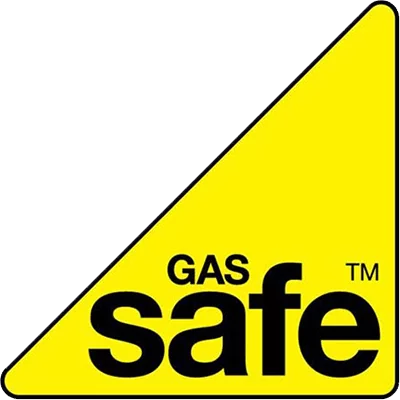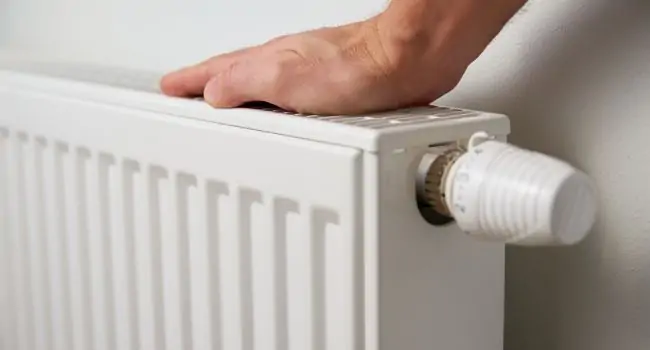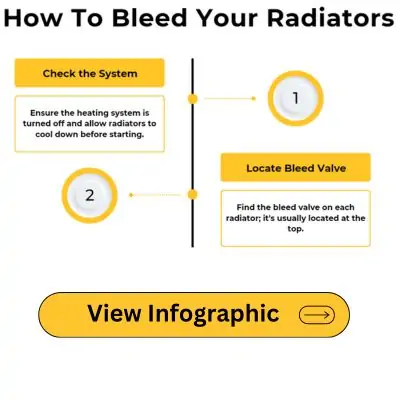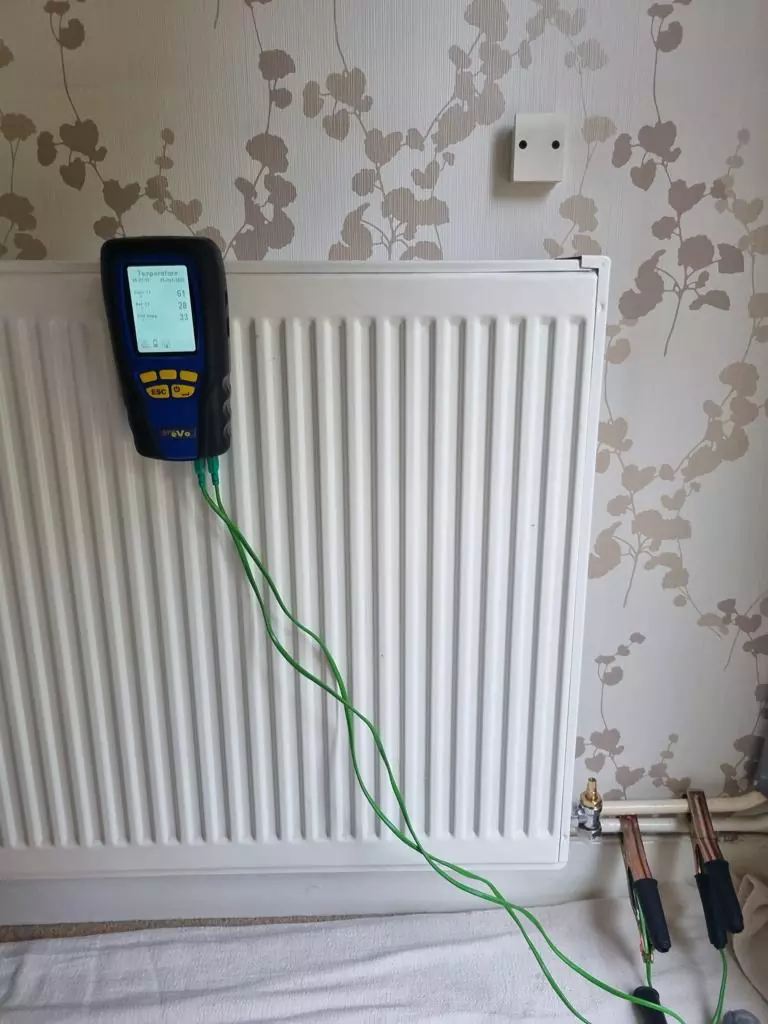Should you find that your radiators are not warming up as they should, it could be necessary to bleed them. Bleeding radiators is a crucial process designed to remove trapped air, thus improving heating efficiency. The question arises, “How does one go about bleeding their radiators?” To enhance heating efficiency and ensure proper functioning of your heating system, a straightforward procedure is employed to eliminate any trapped air from the radiators. We will guide you through this easy yet efficient method and discuss why ongoing upkeep is crucial for maintaining the coziness of your home and reducing energy expenses.
Key Takeaways
Bleeding radiators is vital for removing air pockets that hamper heating efficiency, enhance even heat distribution, and extend the lifespan of the heating system by preventing corrosion and debris buildup.
The essential tools for bleeding radiators include a radiator bleed key (or a flathead screwdriver as an alternative) and an old towel or cloth to catch any drips of water during the process.
A step-by-step radiator bleeding process requires turning off the heating system, identifying which radiators need bleeding, opening the bleed valve using the proper tools, and closing it after air is released, following which checking for leaks is necessary.
Why Radiator Bleeding is Essential
Your central heating system relies heavily on radiators to keep your home warm and comfortable. Their functionality is essential, yet can be impaired by air pockets that prevent the smooth flow of hot water, which is vital for a radiator’s operation. Consistently bleeding all the radiators ensures that heat spreads uniformly throughout your space, alleviating pressure on the boiler and aiding in energy conservation. By routinely monitoring and caring for your radiators, you’re promoting peak efficiency of your entire central heating system.
Regular radiator bleeding has benefits beyond simply improving heating efficiency—it acts as preventative maintenance that can prevent more intensive interventions like full-system flushing while prolonging the life span of your heating setup. To appreciate its significance fully, one must consider how trapped air affects not just current performance but also long-term health through preventing corrosion and hindering debris accumulation within the system. Emphasising the importance of bleeding radiators regularly is crucial for maintaining heating efficiency and overall system health.
The Impact of Trapped Air
Air trapped within your heating system’s radiator can disrupt the seamless circulation of hot water, creating an air pocket that impedes efficient heat distribution. This accumulation of air may occur from filling the system or as a result of leaks and thermal expansion and contraction.
This blockage has two primary effects: it leads to inconsistent warming with cold spots often at the upper section of the radiator, and it burdens your heating system by demanding more energy to maintain desired temperatures due to decreased efficacy.
Preventing Corrosion and Debris Buildup
Just as consistent dental appointments are important for avoiding cavities, the routine bleeding of radiators is key in averting corrosion and accumulation of debris within your heating system. This practice is vital since this buildup can diminish radiator efficiency, resulting in higher energy expenses.
Introducing a chemical inhibitor to your heating system can thwart rust flakes and sludge from forming inside radiators. Keeping this inhibitor at proper levels is critical to fend off rust and corrosion while also maintaining the effectiveness of your heating apparatus through its radiators.
Tools You’ll Need to Bleed Your Radiators
Shifting our focus to the practical aspects, we will delve into the essential tools required for bleeding your radiators. Understanding the role of radiator valves in the bleeding process is crucial for ensuring a smooth operation. You should have a radiator bleed key, an old towel or cloth, and a flathead screwdriver at hand. Each tool has its specific purpose in facilitating the safe and effective completion of bleeding your radiators, particularly in manipulating the radiator’s bleed valve and adjusting the flow.
Now let’s examine each tool more closely to comprehend their individual contributions to this task. The radiator bleed key is specifically designed for use with the radiator’s bleed valve, a critical component in releasing trapped air and ensuring the efficient operation of your heating system.
Radiator Bleed Key
A radiator bleed key is an essential instrument specifically tailored to engage with the bleed valve of a radiator, often referred to as the radiator bleed valve. This key plays a vital role in expelling accumulated air within your heating system by unlocking this valve. Typically located at the uppermost part of the radiator, this bleed valve allows for the escape of any entrapped air.
To ensure convenience during routine upkeep, it’s wise to keep your radiating bleeding tool close at hand—such as inside a toolbox or nestled in a kitchen drawer. By doing so, you’ll save significant time whenever there’s need to address maintenance involving your home’s heating elements and their associated air release processes.
Flathead Screwdriver
If you don’t have a radiator bleed key, a flathead screwdriver can be used as an alternative to bleed your radiators. You should place the screwdriver into the slots of the bleed valve on your radiator and rotate it counterclockwise to open, then clockwise when closing.
Nevertheless, using a flathead screwdriver requires careful handling. This is because there’s potential for damaging the surface of the bleed screw. There’s also an increased risk of harm if by chance the tool were to slip while working with it.
Old Towel or Cloth
A seemingly unusual but essential item for this job is an old towel or cloth. As you bleed a radiator, it’s typical for tiny spurts of water to follow the expelled air. Using an old towel or cloth to capture these drips will help maintain a clean working area.
It’s wise to position a cloth, towel, or washing-up bowl below the bleed valve before initiating the bleeding process in order to guard against any potential water stains on your carpet or flooring. This simple step can save you from unwanted cleanup after optimising your radiator’s performance.
Step-by-Step Guide to Bleeding Your Radiators
Understanding the importance of radiator bleeding and having the necessary equipment at hand, we can proceed with the actual procedure. Executing a proper bleed on your radiators is an uncomplicated task when done correctly. Here’s how to do it in detailed steps:
Shut down your heating system.
Pinpoint which radiators require bleeding.
Find and open up the radiator’s bleed valve.
Utilise a suitable radiator key or screwdriver to turn the valve open.
Listen for that characteristic hissing sound indicating air release from the radiator.
6.Close off this valve promptly as soon as water begins to flow out instead of air
7.Inspect around each bled value you’ve worked on for possible leakage
By adhering closely to these instructions, you’ll be able to successfully expel trapped air from your radiators thereby enhancing your home heating system’s efficiency.
Undertaking this process plays a crucial role in maintaining optimal functionality within your heat distribution setup by purging any encapsulated pockets of air. Thus facilitating improved thermal output while simultaneously easing workload pressure off of one’s boiler unit Without ado let us jump into specifics regarding each step involved.
Turning Off the Heating System
To initiate the procedure, it is crucial to deactivate the heating system. Doing so ensures safety and helps eliminate any chances of hot water or steam leaking while bleeding the radiators. Shutting down the heating mitigates potential issues with boiler pressure that could otherwise harm the system.
Prior to commencing with bleeding, it’s important to allow time for all radiators within the system to reach room temperature after having turned off your heat source.
Identifying Radiators That Need Bleeding
When the heating system is inactive, it’s crucial to pinpoint which radiators require bleeding. Feeling each radiator for uneven heat distribution is an effective method. Those that are warm at the bottom yet remain cool at the top probably have trapped air that must be expelled.
Keep an eye out for any unusual sounds such as clanging, continuous groaning or a hissing noise coming from your radiators. Such auditory cues often signal that there is air caught within the system.
Locating and Opening the Bleed Valve
To proceed with bleeding the necessary radiators, you must find and operate the bleed valve usually located at the top of each radiator. This step is crucial for expelling any trapped air within your heating system. Employ a radiator bleed key or alternatively use a flathead screwdriver to twist anticlockwise and open this valve.
As you successfully turn the bleed valve, anticipate hearing a hissing noise indicative of air being released from inside the radiator. The indication that bleeding has been effectively completed is when water begins to flow out in an uninterrupted stream following all expelled air.
Closing the Bleed Valve and Checking for Leaks
Once water begins to emerge, indicating that the trapped air has been expelled, it’s essential to seal off the bleed valve. Accomplish this by rotating the valve in a clockwise direction with care so as not to cause harm.
Post-sealing of the bleed valve, inspect its vicinity for signs of leakage or dampness. Should any be present, cautiously reinforce the tightness of the bleed valve to halt them. Keep in mind, bleeding your radiators aims at enhancing their performance rather than causing additional issues.
Troubleshooting Common Radiator Bleeding Issues
Even when the bleeding process is performed meticulously, you may still face some typical problems. Such issues can range from a lack of water or air being released from the radiator while trying to bleed it, to ongoing cold spots that remain even after bleeding.
Now let’s delve into these matters more thoroughly to grasp their underlying causes and learn appropriate methods for resolving them.
No Water or Air Escaping
Should you find that neither water nor air is being released while trying to bleed your radiator, this could be symptomatic of several problems. The underlying issues might involve:
An airlock situation
A blockage in the radiator valve
Accumulated sludge throughout the system
Issues stemming from the boiler
While these complications may appear intimidating at first glance, it’s crucial to recognise they are routine and manageable concerns. In facing these challenges, enlisting expert assistance is advisable to guarantee precise diagnosis and effective resolution of the problem.
Persistent Cold Spots After Bleeding
Persistent cold spots can often occur even after bleeding, which could be a sign of an airlock within the heating system if only one radiator is affected. Should these cold spots remain and not stem from trapped air, it’s possible that sludge or problems with circulation in the heating system are to blame.
In cases where such cold spots persist despite attempts at resolving the issue oneself, seeking assistance from one of our qualified heating technicians is recommended. Our fully qualified heating engineer will inspect and tackle any intricate issues with your heating setup.
Maintaining an Efficient Heating System
Bleeding your radiators is an important maintenance task for keeping an efficient heating system. It helps to release trapped air and ensure even heat distribution throughout your home. Other crucial aspects include regular inspections, cleaning radiators, and balancing the heating system. By paying attention to these aspects, you can ensure that your heating system operates efficiently without consuming excess fuel and provides maximum heat distribution and improved comfort.
An unbalanced heating system can lead to uneven heating with some rooms being too hot or too cold, thereby increasing energy usage and costs. To avoid this, it’s crucial to maintain your heating system regularly and keep it in optimal condition.
Regular Inspections
A skilled heating technician performing routine checks can:
Detect and resolve early problems with the heating system
Avert expensive malfunctions of the heating system
Ensure that the manufacturer’s warranty remains in effect.
Consider these periodic evaluations as a contribution to sustaining and enhancing your heating system’s efficiency and longevity, rather than merely an outlay. Remember, taking preventative actions typically incurs less cost than footing repair bills.
Cleaning Radiators
Maintaining your radiator involves not only periodic checks, but also thorough cleaning to guarantee that air can circulate efficiently. By preventing the build-up of dust and debris, you ensure your radiators function optimally.
Commence by employing a vacuum equipped with a brush attachment to suction off superficial dust from the radiator. Should there be stubborn detritus nestled amidst the fins or columns of the radiator, utilise a specialised radiator brush for removal. Conclude this maintenance routine by meticulously wiping down every surface of the radiator using microfiber cloths, thereby eradicating any residual particles of dust.
Balancing Your Heating System
Ensuring your heating system is well-balanced is an essential aspect of maintenance. When you balance your radiators, you guarantee that the hot water is distributed evenly across them all, which optimises boiler performance and ensures heat spreads effectively throughout your home for increased comfort.
If a heating system isn’t balanced correctly, it can cause inconsistent temperatures in different rooms—some may become excessively warm while others remain chilly. This imbalance not only affects comfort, but also raises energy consumption and bills. Balancing involves carefully adjusting the valves on each radiator so they all warm up uniformly, thus conserving energy and improving overall warmth in the house.
Summary
An optimally functioning heating system relies not only on cutting-edge boilers or top-notch radiators, but also on consistent upkeep such as radiator bleeding. By habitually bleeding your radiators, you can enhance their effectiveness, prolong their service life, and decrease energy expenditures.
Take hold of a bleed key for the radiator or use a flathead screwdriver to commence the process of bleeding your radiators. Frequent examinations and cleansing of your radiators coupled with fine tuning the balance in your heating system will ensure that your residence remains snug throughout the cold season.
Frequently Asked Questions
Why is radiator bleeding important?
The process of bleeding radiators is essential for removing air pockets that may impede the smooth circulation of water and avert the accumulation of corrosion and debris.
By doing so, it guarantees that your home’s heating operates efficiently.
What tools do I need for radiator bleeding?
To carry out the process of bleeding a radiator, which is essential for expelling surplus air and ensuring its efficient operation, it’s necessary to equip yourself with either a bleed key specifically designed for radiators or a flathead screwdriver. Have an old towel or cloth on hand to manage any drips.
What are the steps to bleed a radiator?
Firstly, switch off the heating system and pinpoint which radiators require bleeding. Subsequently, initiate the process by opening the bleed valve on each identified radiator. Continue until water starts to flow out steadily without emitting any air in a hissing sound before closing the valve again.
What should I do if no water or air is escaping from the radiator during the bleeding process?
During the radiator bleeding process, if there is an absence of both water and air being released, this could point to several potential complications including an airlock situation, a blockage within the radiator valve or sediment buildup inside the heating system.
To ensure accurate diagnosis and resolution of these issues, enlisting the services of a professional like us is highly recommended.
How can I maintain an efficient heating system?
Ensure that your heating system operates at peak efficiency by arranging routine power flushing and boiler servicing, purifying the radiators, and adjusting the setup for even distribution.
Implementing these steps will help in maintaining an effective and efficient performance of your heating infrastructure.




